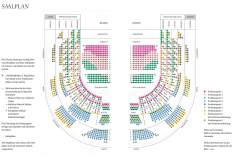Lohengrin
Mo | Tu | We | Th | Fr | Sa | Su |
Synopsis
1. ACT
King Henry's Saxon army marches into the Duchy of Brabant on the banks of the Scheldt. The leaderless neighboring country is to join Henry's campaign against the Hungarians. However, the question of succession in the duchy must first be decided. Henry favors Count Frederick of Telramund. He accuses Elsa of Brabant, the first-born daughter of the deceased duke, of having drowned her younger brother Gottfried, the heir to the throne. Elsa is summoned to court. Instead of defending herself, she conjures up the image of an unknown knight who will prove her innocence in a court of God, marry her and succeed her father.
The appeal of a defender who would be prepared to fight Frederick of Telramund "to the death" initially goes unanswered until an unknown man approaches across the water, whose strangeness casts a spell over everyone. After an address of loyalty to King Henry and before he faces the duel with Frederick of Telramund, Elsa must promise him never to ask his name and identity, whereupon he declares his love for her. The subsequent judgment of God decides against Frederick of Telramund. Brabants and Saxons cheer the Nameless One.
2. ACT
Only Ortrud, the wife of Friedrich von Telramund, doubts the divine legitimacy of the Nameless One. The outsider, who has not converted to Christianity, claims to have witnessed Elsa's murder of Gottfried. She persuades her husband, who has been declared outlawed, to attempt to disenchant the Nameless One: she herself will manipulate Elsa into asking the forbidden question after all, he should publicly accuse the Nameless One of sorcery; even if she succeeds in seizing a limb of his body, however small, his power would be broken. Ortrud succeeds in being accepted back into Elsa's grace.
The Nameless One has himself declared 'Protector of Brabant' and agrees with King Henry that, following his marriage to Elsa, he will lead the Brabant army to war alongside Henry's troops. Fuelled by the belief in the new ruler's divine mission, the general mobilization of Brabant begins at the same time as the wedding preparations.
On the way to the wedding, Ortrud confronts the bride and publicly raises doubts about the identity of the nameless man, before Frederick also questions the legitimacy of God's judgment, as he has failed to establish the name and origin of his rival. The battle-ready Saxons and Brabants are not interested in such a clarification. However, it is only when Elsa publicly declares her own doubts about the "Protector of Brabant" to be overcome that the wedding can take place.
3. ACT
Elsa and the Nameless One are led into the bridal chamber. Elsa demands a share in her husband's secret so that she can take conscious responsibility for keeping it, for which she would be prepared to risk her life. The Nameless One refuses, but in return offers her the chance to forgo a precise clarification of the background to her brother's disappearance.
Nevertheless, Elsa asks the forbidden question - regardless of herself or him. At this moment, Frederick of Telramund, who had been in hiding, emerges and is struck down by the Nameless One.
At dawn, the Nameless One declares his resignation before the marching armies of Saxony and Brabant: by asking the forbidden question, Elsa has stripped him of all power, for the success of his mission was linked to the secret of his identity. lnce he now reveals himself as Lohengrin and son of the Grail King, he must withdraw. With his final disappearance, he gives Brabant back the lost heir to the throne, Gottfried.
ACT 1 - 60 MIN
INTERMISSION - 25 MIN
ACT 2 - 80 MIN
INTERMISSION - 25 MIN
ACT 3 - 60 MIN
Program and cast
King Henry: Georg Zeppenfeld; Günther Groissböck*
Lohengrin: David Butt Philip
Elsa of Brabant: Malin Byström; Camilla Nylund*
Telramund: Martin Gantner: Jordan Shanahan*
Ortrud: Anja Kampe
Herald: Attila Mokus
Musical Director: Christian Thielemann
Director: Jossi Wieler, Sergio Morabito
Stage & Costumes: Anna Viebrock
Light: Sebastian Alphons
Co-Set Designer: Torsten Köpf
*27 April 2025; 1 May 2025; 4 May 2025
Vienna State Opera
Public Transport
Subway lines: U1, U2, U4
Trams: 1, 2, D, J, 62, 65
Buses: 59A
Local Railway: Badner Bahn
Stops: Karlsplatz / Opera
Taxi stands are available nearby.
Parking
Parking is only € 6, - for eight hours!
The Wiener Staatsoper and the ÖPARK Kärntner Ring Garage on Mahlerstraße 8, under the “Ringstraßengalerien”, offer the patrons of the Vienna State Opera a new, reduced parking fee. You can park in the Kärntner Ring Garage for up to 8 hours and pay only a flat fee of € 6, -. Just validate your ticket at one of the discount machines inside the Wiener Staatsoper. The normal rate will be charged for parking time greater than 8 hours. The validation machines can be found at the following coat checks: Operngasse, Herbert von Karajan-Platz, and the right and left and balcony galleries.
Important: In order to get the discount, please draw a ticket and do not use your credit card when entering the garage!
After devaluing your ticket in the Wiener Staatsoper you can pay comfortably by credit card or cash at the vending machines.
The machines accept coins and bills up to 50.- Euro. Parking time longer than 8 hours will be charged at the normal rate.
History
The structure of the opera house was planned by the Viennese architect August Sicard von Sicardsburg, while the inside was designed by interior decorator Eduard van der Nüll. It was also impacted by other major artists such as Moritz von Schwind, who painted the frescoes in the foyer, and the famous "Zauberflöten" (“Magic Flute”) series of frescoes on the veranda. Neither of the architects survived to see the opening of ‘their’ opera house: the sensitive van der Nüll committed suicide, and his friend Sicardsburg died of a stroke soon afterwards.
On May 25, 1869, the opera house solemnly opened with Mozart's Don Giovanni in the presence of Emperor Franz Joseph and Empress Elisabeth.
The popularity of the building grew under the artistic influence of the first directors: Franz von Dingelstedt, Johann Herbeck, Franz Jauner, and Wilhelm Jahn. The Vienna opera experienced its first high point under the direction of Gustav Mahler. He completely transformed the outdated performance system, increased the precision and timing of the performances, and also utilized the experience of other noteworthy artists, such as Alfred Roller, for the formation of new stage aesthetics.
The years 1938 to 1945 were a dark chapter in the history of the opera house. Under the Nazis, many members of the house were driven out, pursued, and killed, and many works were not allowed to be played.
On March 12, 1945, the opera house was devastated during a bombing, but on May 1, 1945, the “State Opera in the Volksoper” opened with a performance of Mozart's THE MARRIAGE OF FIGARO. On October 6, 1945, the hastily restored “Theaters an der Wien” reopened with Beethoven's FIDELIO. For the next ten years the Vienna State Opera operated in two venues while the true headquarters was being rebuilt at a great expense.
The Secretary of State for Public Works, Julius Raab, announced on May 24, 1945, that reconstruction of the Vienna State Opera would begin immediately. Only the main facade, the grand staircase, and the Schwind Foyer had been spared from the bombs. On November 5, 1955, the Vienna State Opera reopened with a new auditorium and modernized technology. Under the direction of Karl Böhm, Beethoven’s FIDELIO was brilliantly performed, and the opening ceremonies were broadcast by Austrian television. The whole world understood that life was beginning again for this country that had just regained its independence.
Today, the Vienna State Opera is considered one of the most important opera houses in the world; in particular, it is the house with the largest repertoire. It has been under the direction of Dominique Meyer since September 1, 2010.

 EN
EN DE
DE IT
IT FR
FR ES
ES RU
RU JP
JP RO
RO
 Seating plan
Seating plan